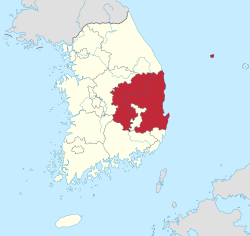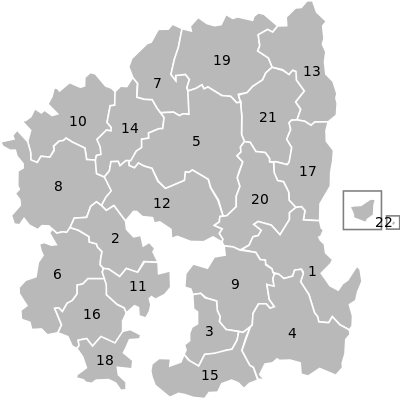Loading AI tools
Province of South Korea From Wikipedia, the free encyclopedia
North Gyeongsang Province (Korean: 경상북도; RR: Gyeongsangbuk-do, Korean pronunciation: [kjʌŋ.saŋ.buk̚.t͈o]) is a province in eastern South Korea, and with an area of 18,420 km2 (7,110 sq mi), it is the largest province in the Korean peninsula. The province was formed in 1896 from the northern half of the former Gyeongsang province, and remained a province of Korea (as Keishōhoku-dō during Japanese rule) until the country's division in 1945, then became part of South Korea.
North Gyeongsang Province
경상북도 | |
|---|---|
| Korean transcription(s) | |
| • Hangul | 경상북도 |
| • Hanja | 慶尙北道 |
| • McCune‑Reischauer | Kyŏngsangbuk-to |
| • Revised Romanization | Gyeongsangbuk-do |
 | |
| Country | |
| Region | Yeongnam |
| Largest city | Pohang |
| Capital | Andong |
| Subdivisions | 10 cities; 12 counties |
| Government | |
| • Governor | Lee Cheol-woo (People Power) |
| Area | |
| • Total | 19,030 km2 (7,350 sq mi) |
| • Rank | 1st |
| Population (October, 2014)[1] | |
| • Total | 2,546,960 |
| • Rank | 3rd |
| • Density | 141.7/km2 (367/sq mi) |
| Demonym | Gyeongbukite |
| Metropolitan Symbols | |
| • Flower | Crape-myrtle |
| • Tree | Zelcova |
| • Bird | Common heron |
| GDP | |
| • Total | KR₩ 115 trillion US$ 92 billion (2022) |
| ISO 3166 code | KR-47 |
| Dialect | Gyeongsang |
| Website | Official website (English) |
Daegu was the capital of North Gyeongsang Province between 1896 and 1981, but has not been a part of the province since 1981. In 2016, the provincial capital moved from Daegu to Andong.[3]
The 1,000-year-old Silla Kingdom flourished and unified the previous three kingdoms. The area was named Gyeongsang-do in 1314 during the Goryeo Dynasty. In 1896, during the Joseon Dynasty, the area was renamed Gyeongsangbuk-do as 13 roads were reorganized. The current administrative district was reorganized with the reorganization of Bu, Gun, and Myeon in 1914.[4]
The province is part of the Yeongnam region, bordered to the south by South Gyeongsang Province, to the west by North Jeolla and North Chungcheong Provinces, and to the north by Gangwon Province. It is largely surrounded by mountains: the Taebaek Mountains in the east and the Sobaek Mountains in the west.[citation needed]
Andong Sikhye, a local food from Andong and northern North Gyeongsang Province, is essential for entertaining guests on Seollal or feast days. Unlike ordinary Sikhye, it is red with Chili powder, has more grains of rice, and less soup.[5]
North Gyeongsang Province is the homeland of the former kingdom of Silla and has retained much of its cultural tradition. A number of artists, political leaders and scholars have come from the province.
| Year | Pop. | ±% p.a. | ||
|---|---|---|---|---|
| 1980 | 3,102,060 | — | ||
| 1990 | 2,766,797 | −1.14% | ||
| 2000 | 2,724,931 | −0.15% | ||
| 2010 | 2,600,032 | −0.47% | ||
| 2015 | 2,680,294 | +0.61% | ||
| 2020 | 2,644,757 | −0.27% | ||
| ||||
| Source: Citypopulation[6] | ||||
According to the census of 2015, 25.3% followed Buddhism and 18.5% followed Christianity (13.3% Protestantism and 5.2% Catholicism). 55.4% of the population is irreligious.[8]
Gyeongsangbuk-do is divided into 10 cities (si) and 12 counties (gun). The names below are given in English, hangul, and hanja. Gyeongsang do is originated from Gyeongju & Sangju old city of Gyeong+Sang from Joseon Dynasty (1392–1910). Do means road to 8 directional road from Seoul. Pohang is Korean steel production hub, Gumi is electronics capital of South Korea.

| Map | # | Name | Hangul | Hanja | Population (2024)[9] | Subdivisions |
|---|---|---|---|---|---|---|
 | ||||||
| — Specific City — | ||||||
| 1 | Pohang | 포항시 | 浦項市 | 492,041 | 2 ilban-gu — 4 eup, 10 myeon, 15 haengjeong-dong | |
| — City — | ||||||
| 2 | Gumi | 구미시 | 龜尾市 | 404,691 | 2 eup, 6 myeon, 19 haengjeong-dong | |
| 3 | Gyeongsan | 경산시 | 慶山市 | 266,951 | 2 eup, 6 myeon, 7 haengjeong-dong | |
| 4 | Gyeongju | 경주시 | 慶州市 | 245,365 | 4 eup, 8 myeon, 11 haengjeong-dong | |
| 5 | Andong | 안동시 | 安東市 | 153,348 | 1 eup, 13 myeon, 10 haengjeong-dong | |
| 6 | Gimcheon | 김천시 | 金泉市 | 135,767 | 1 eup, 14 myeon, 7 haengjeong-dong | |
| 7 | Yeongju | 영주시 | 榮州市 | 99,309 | 1 eup, 9 myeon, 9 haengjeong-dong | |
| 8 | Sangju | 상주시 | 尙州市 | 92,452 | 1 eup, 17 myeon, 6 haengjeong-dong | |
| 9 | Yeongcheon | 영천시 | 永川市 | 99,034 | 1 eup, 10 myeon, 5 haengjeong-dong | |
| 10 | Mungyeong | 문경시 | 聞慶市 | 67,544 | 2 eup, 7 myeon, 5 haengjeong-dong | |
| — County — | ||||||
| 11 | Chilgok County | 칠곡군 | 漆谷郡 | 108,119 | 3 eup, 5 myeon | |
| 12 | Uiseong County | 의성군 | 義城郡 | 56,777 | 1 eup, 17 myeon | |
| 13 | Uljin County | 울진군 | 蔚珍郡 | 46,112 | 2 eup, 8 myeon | |
| 14 | Yecheon County | 예천군 | 醴泉郡 | 45,948 | 1 eup, 11 myeon | |
| 15 | Cheongdo County | 청도군 | 淸道郡 | 43,787 | 2 eup, 7 myeon | |
| 16 | Seongju County | 성주군 | 星州郡 | 44,824 | 1 eup, 9 myeon | |
| 17 | Yeongdeok County | 영덕군 | 盈德郡 | 40,213 | 1 eup, 8 myeon | |
| 18 | Goryeong County | 고령군 | 高靈郡 | 35,281 | 1 eup, 7 myeon | |
| 19 | Bonghwa County | 봉화군 | 奉化郡 | 33,936 | 1 eup, 9 myeon | |
| 20 | Cheongsong County | 청송군 | 靑松郡 | 26,432 | 1 eup, 7 myeon | |
| 21 | Yeongyang County | 영양군 | 英陽郡 | 18,259 | 1 eup, 5 myeon | |
| 22 | Ulleung County | 울릉군 | 鬱陵郡 | 10,557 | 1 eup, 2 myeon | |
In October 2022, the Province announced its plan to make the province a leading area centered on the domestic metaverse. It is also a specialized complex for semiconductor and secondary battery national high-tech strategic industries.[10]
The service industry accounts for 58.3%, mining manufacturing industry account for 30.6%, construction account for 10.5%, and agriculture and fishing account for 0.6%. Mobile convergence, digital device parts, and energy material parts are major specialized industries.[11]

The railway stations in North Gyeongsang Province are as follows:
In September 2021, archaeologists announced the discovery of 1500 years-old woman skeleton with a necklace and a bracelet in North Gyeongsang Province. The remains of a 135-centimeter-tall woman, who is estimated to have died in her 20s, were discovered along with the bones of animals such as horses and cows, as well as earthenware.[12][13][14][15]


Seamless Wikipedia browsing. On steroids.
Every time you click a link to Wikipedia, Wiktionary or Wikiquote in your browser's search results, it will show the modern Wikiwand interface.
Wikiwand extension is a five stars, simple, with minimum permission required to keep your browsing private, safe and transparent.